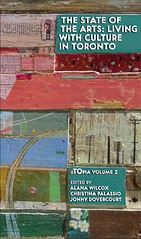DC's "cultureshed"

I wish I invented the word "cultureshed" after all, I write about the transitshed, and I probably coined the word "mobilityshed." But cultureshed is a word used in the opening essay, "The City as cultureshed," by John Lorinc in the book The State of the Arts: Living with Culture in Toronto, which is a survey of the state of cultural affairs there, in part a response by the ground up arts and culture communities to the designation of Toronto as Canada's City of Culture in 2005-2006 and the official actions in response. He writes:
... That's why we should begin to think of cities as 'culturesheds'--deeply interconnected social, physical and economic ecosystems that may be more or less attuned to the circulation of artistic ideas. As Toronto emerges from its year of culture (2006), decked out with a raft of shiny new arts venues and the promotional attention of international tourist marketers, we should be asking ourselves whether the city's cultureshed is healthy or endangered, growing or stagnant.
I've written about this as it relates to DC for while, including the blog entry "Art, culture districts, and revitalization" which was the basis of a presentation at a conference of North American dramaturgs and theater companies last summer.
I have to say that I was truly shocked to read the draft DC economic development strategy plan, (NOTE that public comments are due by August 1st) and I found that the discussion of the issues concerning the creation of "A Creative, Innovative & International City" was direct, honest, and covered many of the issues that I have raised over the years about developing a knowledge-based innovative economy within the city.
The points mentioned include:
- failure to link with "cutting edge research and development" assets
- limited linkage of research to patents, products, and "commercially viable companies"
- failure to develop university academic departments in ways that leverage the opportunity for federal agency development constrasts
- no technology incubation system
- cost pressures of space (and note that my suggested Comprehensive Plan amendment not allowing schools and churches to use industrially zoned properties as a "matter of right" was rejected)
- limited venture capital.
While I haven't had a chance yet to read the Creative DC Action Agenda, I am not surprised that the economic development strategy didn't mention how DC arts institutions and creative organizations tend to be large institutions, presenting institutions, and less likely to be promoting and developing the creation of new work.
This isn't true across the board, but it is a big issue in terms of developing arts production capabilities versus the consumption of artistic activities such as going to museums, or to Broadway plays presented at local theaters, etc.

I guess it shouldn't be a surprise, given the difficulties of supporting ground up artistic endeavors, that I hear a proposal to put Artomatic--the cooperative ground up mobile artistic exhibition--at the soon to be redeveloped Hine Junior High School site, which is less than 100 feet from the Eastern Market Metro Station (see "Artomatic talks locale" is being opposed by neighborhood organizations such as the local Advisory Neighborhood Commission and Capitol Hill Restoration Society, the stalwart historic preservation group, in part because of fears that attendees would drive cars to the event and then park on local streets.
(All the more reason to have a neighborhood transportation plan that manages parking and parking wayfinding, something I've suggested for a few years now, ever since I joined the Eastern Market Citizens Advisory Committee.)
Doing creative, ground-up arts development is very difficult in a city where I joke "big government [the federal government] trickles down and shapes little government [the local government] and the citizens in its image."
Labels: arts-based revitalization, arts-culture, civic engagement, cultural heritage/tourism, cultural planning, music-entertainment, nonprofit management



0 Comments:
Post a Comment
<< Home